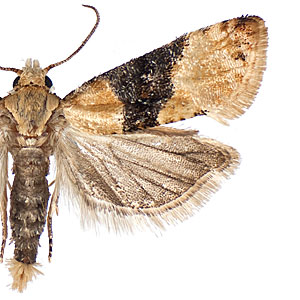Overview
![]()
The tribe Cochylini contains approximately 1,000 described species in 80 genera. Its members are present worldwide, although the greatest species diversity occurs in the Holarctic and Neotropics. The group is defined by wing venation, wing pattern, and to a lesser extent, genitalic characters. The wing pattern of many species is similar, with yellow or white ground color and one or two distinct, reddish brown fasciae. Often the median fascia only extends partway from dorsum to costa, creating the appearance of a dorsal patch. Male genitalia are characterized by triangular or rectangular valvae and a very large aedeagus. Female genitalia are characterized by a short, broad, ductus bursae, and a corpus bursae with numerous wrinkles, sclerotizations, or spines.
The group contains a number of economically important species. In much of the economic literature it is still treated as a distinct family or subfamily (Cochylidae or Cochylinae), although it is currently considered a tribe within the Tortricinae. Brown (2006) outlines the history of placement of this group. Only two species are treated here. Eupoecilia ambiguella is an important pest of grapes in the Palearctic, and its larvae cause damage similar to that of Lobesia botrana. Henricus umbrabasana is a Californian species that is commonly collected as a non-target in Epiphyas postvittana traps. For photos of additional non-targets not covered here, visit the Moth Photographers Group link below.
Larvae are primarily internal feeders in seeds, stalks, and roots. Larval morphology for the group is unusual in that larvae share the following character states with those of Grapholitini (Olethreutinae): D1 and SD1 are on the same pinaculum on A9, and the L pinaculum on T1 is enlarged and extends beneath the spiracle. In some species (e.g., E. ambiguella), the L-group does not extend past (posterior to) the spiracle as it does in many of the olethreutines with a similar state (Cryptophlebia, some Cydia, Ecdytolopha, Gymnandrosoma, and Thaumatotibia). Other larval characters include an anal comb with 2-10 teeth and the L pinaculum on A9 bisetose.
Cochylini larvae are commonly intercepted at U.S. ports of entry on products arriving from Central America. One commonly recorded host is monkeypod (Pithecellobium dulce) from Mexico.
Target species
Non-target species






